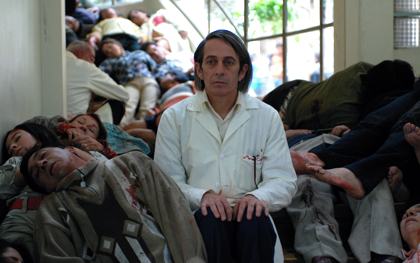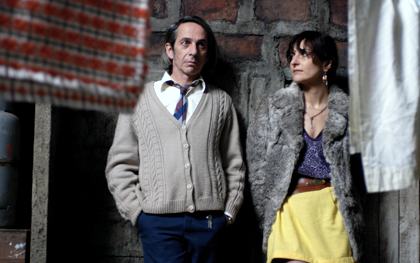Primary navigation


A neurotic Chilean mortuary assistant in the year of Pinochet’s coup is the focus of Post Mortem, a character study that’s every bit as distinctive and chilling as Pablo Larraín’s last film Tony Manero. By Jonathan Romney
At the end of M. Night Shyamalan’s The Sixth Sense, we discovered together with Bruce Willis’s supposedly living character that he had really been dead all along. It sometimes happens in non-genre films too that we sense we are watching characters who, although ostensibly operating as living beings in real environments, are to all intents and purposes dead already – figuratively, that is, rather than in a supernatural sense. This is the case with many films by certain directors – Béla Tarr, Lisandro Alonso, Raúl Ruiz, Jim Jarmusch come to mind – whose characters often seem akin to phantoms re-enacting actions they might have performed when alive.
Detecting such wraiths in the skin of supposedly living characters is often purely a matter of the viewer’s perception, but the effect presents itself in a more heightened form in the case of Mario Cornejo (Alfredo Castro), the anti-hero of Pablo Larraín’s Post Mortem. The title gives the game away, suggesting that Mario not only literally assists in autopsies, but that he himself is somehow eking out a post-death existence on earth. The implication too is that Chile – in 1973, the year of the Pinochet coup – is already in a post-mortem state: a country of ghosts, with the murderous military regime seemingly intent on turning the nation into a republic of the dead.
Post Mortem is a follow-up to Larraín’s extraordinary second film Tony Manero (2008), about one man’s pathological state of denial during the Pinochet regime. The new film takes Tony Manero’s sardonically macabre humour even further. On one level, Post Mortem can be read as a realistic drama about an ordinary man – albeit a highly disturbed one – who goes about his daily business before being caught up in the traumatic events of September 1973. But several things militate against the film being read too literally. One is a disconcerting scene out of sequence – an apparent flash-forward in which Mario’s neighbour and sometime lover Nancy (Antonia Zegers) appears inexplicably as a corpse under examination. Another factor is the treatment of the relationship between Nancy and Mario, whose glaring eccentricity is distinctly at odds with conventional psychological drama. Nancy is self-regarding, flamboyantly neurotic – and seemingly a perfect mate for Mario; when she inexplicably starts crying in an extraordinary extended scene, Mario suddenly, hysterically starts weeping too, tears and snot dripping off his face. Mario is played by Alfredo Castro, who was so peerlessly creepy in Tony Manero as the sociopathic disco king Raúl; and if anything, he’s stranger still here, thin to the point of resembling a newly exhumed corpse or a morbidly floppy marionette, with lank hair falling over his usually expressionless face.

Then there is the film’s stylisation; it may be in part a brilliant response to budget limitations, but it works to extraordinary effect, the action seeming to take place in an uncannily still dream world. The explosive drama of the coup d’état figures as a conspicuous absence, prefigured in the opening image, shot from beneath the undercarriage of a military vehicle passing over an empty street littered with debris. The coup’s eruption is heard off screen, missed by Mario, who happens to be taking a shower as it happens. We hear planes passing overheard, glass smashing, the noise of crowds – and then silence, as Mario steps out into a deserted street.
But the city of Santiago seems just as ghostly before the coup as it does after. From the start of the film, Mario’s world echoes with hollow, distant sounds as if we’re in an aquarium (the buzz of electric lights, a phantom cancan echoing in the corridors of the variety theatre), while Sergio Armstrong’s photography (in 16mm, blown up to 35mm) is a nauseous palette of pale greens, browns, purples and pinks that evoke the discolouration of a cadaver. The widescreen framing is unsettlingly eccentric too, suggesting bodies trapped in frames, windows and boxes, or on stage-like performance spaces.
The film falls into two distinct chapters. One depicts the relationship between two lonely and disturbed people – the man an ineffectual, solitary masturbator and the woman a deranged narcissist – who share only their desperation and their intense denial of what’s going on around them. Driving in his car, Mario and Nancy are in a hurry to get away from the political reality of the socialist demonstration they’ve wandered into (manifestly a communing of the already dead, or at least the marked-for-death). Nancy later lets out a cri de coeur of blind denial after her house has been destroyed, and her younger brother and union-activist father have disappeared: “We don’t have anything to do with this. We’re peaceful people. Call the police.”
The second chapter, recounting the coup’s aftermath, is more overtly nightmarish. In a distressing scenario – clearly drawn from reality, but echoing the visual metaphors of absurdist theatre – corpses pile up in corridors and on stairwells, like so much backlogged material to be processed by the bureaucracy of death, of which Mario is now a part. Once the military is in power, the coroners’ job is no longer to investigate the causes of death, simply to record and quantify – literally, to count the bullet holes.
Larraín seems to offer two overt elements of political commentary. One is the sequence in which, with massed top brass in attendance, Mario’s boss Dr Castillo performs an autopsy on a mutilated corpse, which we learn is that of Salvador Allende; Castillo concludes that the deposed president could have shot himself – the suggestion being that the coroner is colluding in the official cover-up of his presumed assassination. (Though in fact a new autopsy performed this July confirmed that Allende did indeed take his own life.) Another key element is the change in Castillo, who is heard at one point voicing leftist sentiments about following the example of Ho Chi Minh; despite such rhetoric, he quickly becomes a meek servant of the new order (not that, under military surveillance, he has much choice).

It is not clear precisely what Larraín is saying about 1973 Chile. The suggestion perhaps is that the nation was already in a state of somnambulistic denial – of the kind depicted in Tony Manero – even before the coup. Indeed the entertainment at the theatre visited by Mario – a cancan line, a weary stand-up and, judging from the manager’s comments, some raunchier fodder – is a horribly archaic, deadened form of bread and circuses. The implication is that – unlike the morts vivants Mario, Nancy and Castillo – only those who resisted and were slaughtered had a true claim to be alive.
Not that this is a world entirely without hope or compassion – Mario’s colleague Sandra protests bitterly at the horrors that the morgue workers are made to participate in, though her cries are silenced by a soldier’s warning gunshots, signifying that her card too is marked. There’s a certain compassionate gentleness in Mario’s comportment, too: dragging a corpse-laden trolley down the morgue’s basement corridor, his actions suggest respectful duty, as if he’s become Charon, ferrying the dead to the underworld. Notably, he and Sandra try and save a lone survivor from the hecatomb; but it’s typical of the film’s subtlety that the wounded man – and the hospital nurse who takes him in – are simply glimpsed later, without commentary, as bodies on the pile.
Despite his capacity for quiet resistance, however, Mario finally embraces the new order’s death drive. The difficulty of the film stems from the way it presents the cataclysm from the perspective of a disturbed protagonist, the horror of 1973 conflated with the turbulence of Mario’s psyche in a harrowing final image in which he finally becomes not just death’s attendant but its executor. This grim tableau, observed with chill matter-of-factness, puts the final stamp on an enigmatic but utterly distinctive and troubling film.
The body politic: Pablo Larraín talks to Demetrios Mattheou (October 2011)
Raúl Ruiz, 1941-2011: obituary by Jonathan Romney (August 2011)
Nostalgia for the Light reviewed by Nick Bradshaw (November 2010)
The Secret in Their Eyes reviewed by Maria Delgado (September 2010)
Tony Manero reviewed by Jonathan Romney (May 2009)
Liverpool: Lisandro Alonso interviewed by Maria Delgado (November 2008)
The Lives of Others reviewed by Geoffrey Macnab (May 2007)
Broken Flowers reviewed by Liese Spencer (November 2005)
Werckmeister Harmonies reviewed by Jonathan Romney (April 2003)
The Sixth Sense reviewed by Philip Strick (November 1999)